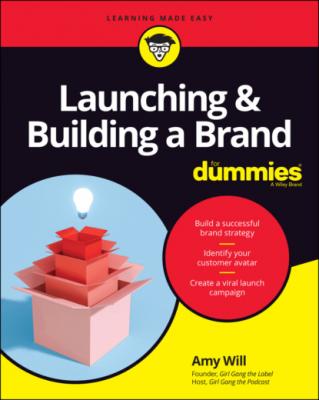ТОП просматриваемых книг сайта:
Launching & Building a Brand For Dummies. Amy Will
Читать онлайн.Название Launching & Building a Brand For Dummies
Год выпуска 0
isbn 9781119748052
Автор произведения Amy Will
Жанр Малый бизнес
Издательство John Wiley & Sons Limited
Artist/inventor
Caregiver
Explorer
Friend
Smart
Hero(ine)
Innocent
Magician
Minimalistic person
Confident
Leader
Writing your brand identity statement
When you have an intimate understanding of “who” your brand is — its mission, vision, values, and personality — you’re ready to formalize it in the form of a brand identity statement. In this section, I lead you through the process.
Covering the essentials
When writing your brand identity statement, make sure that it includes the following essential elements:
Your brand’s name or tentative name: Discussed in the later section “Naming Your Brand”
Your brand’s point of differentiation: What your brand offers that’s better than the alternatives
Your target market: The people you most want to be enthusiastic about your brand
Your brand’s mission or vision: Its purpose
Your brand’s values: The one or two at the top of your list
Your brand’s personality: Traits that you express in words or in the tone of your brand identity statement
Structuring your brand identity statement
Your brand’s identity is its essence — its lifeblood. This identity is communicated through the brand’s name, logo, tagline, content marketing, advertising, signage, and public engagement.
Your brand identity statement guides everything you do to develop the brand identity you want to project. This statement must cover all the essentials listed in the previous section clearly and succinctly. Here’s a template for structuring your brand identity statement, but don’t feel locked into it:
[Brand name] offers [point of differentiation] to [target market]. We are committed to [mission] through [values] with our [brand personality].
Here’s an example:
Athletipro offers a quick and easy online shopping experience and speedy delivery of equipment and supplies to amateur and professional athletes and everyone in between. We’re committed to empowering each customer to achieve optimal health, fitness, and performance through research and innovation with our unequaled passion and drive.
Testing your brand identity statement
Before you invest time and effort developing a brand consistent with your brand identity statement, put it to the test. Seek feedback from others within your organization and from people outside your organization, preferably from existing or prospective customers in your target market. But you can consult friends and family members if the other options aren’t available.
As you gather feedback, use it to answer the following questions:
Does your brand identity statement resonate with people and appeal to what matters most to them? If not, find out what would appeal to them.
Is the promise (mission) conveyed in your brand identity statement realistic, and can your brand deliver it consistently? If you’re talking to existing customers, ask them whether they think your brand is living up to its promise.
What’s the brand’s perceived personality, and how does it compare with how you want your brand to be perceived?
What do you think you need to do to bring people’s perception of your brand more in line with the brand identity you envision?
Naming Your Brand
Now more than ever, you need to catch the attention of prospective customers quickly and hold it for more than a few seconds. People are constantly being inundated with advertisements and offers, so your brand name needs to stand out. Choosing a brand name is one of the most important branding decisions you’ll ever make.
Maybe you have a brand name in mind; maybe you don’t. Either way, work through the brand-naming process described in this section. If you don’t have a name in mind, this process will stimulate your creativity. If you already have a name in mind, this process will put it to the test and perhaps even lead you to a much better name.
The process of naming your brand can influence your decisions about brand positioning and identity; it can elevate your concept of the brand and its mission and values. Outdoor Voices, an athleisure brand, was inspired by adults encouraging children to use their “inside voices.” Outdoor Voices encourages the opposite. Its mission is “to get the world moving” with active wear for both indoor and outdoor recreation. The brand targets teens and adults who want to step outside their comfort zones.
Following brand naming parameters
Before you start thinking about naming your brand, be aware of the following characteristics of a good brand name:
Positions your brand advantageously
Clearly communicates your brand’s identity
Reflects your brand’s promise or offerings
Is easy to say and spell
Is unique — available to trademark and available as a domain name (for use as a website address and part of your email address)
Is memorable and concise
Accommodates future expansion
Is consistent with your chosen brand architecture — a branded house or a house of brands (see Chapter 1)
Here are a few examples of descriptive brand names to use as inspiration:
AutoZone vehicle parts and supplies
Energizer batteries
Drano drain opener
Mr. Clean household cleaner
Ziploc storage bags
Windex glass cleaner
Dairy Queen ice cream

